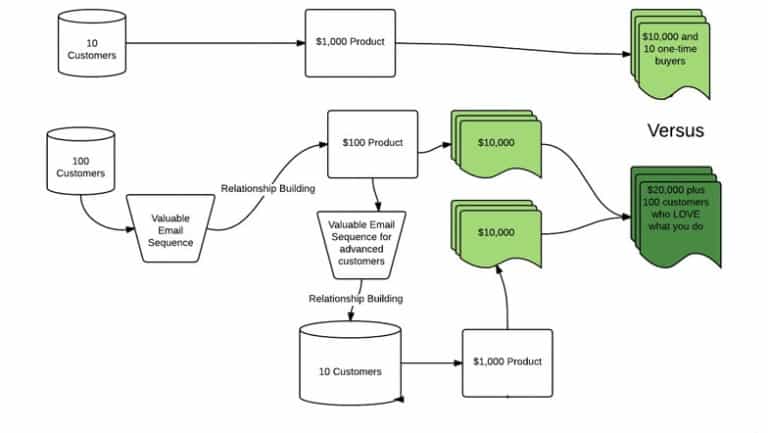Unclog Your Traffic Pipeline with these Little-Known, Counterintuitive Facts about How to Get Paying Customers Through Your Door
Here’s the straight truth that nobody tells you about traffic:
It’s easy to get.
Almost anyone who can slap “marketing guru” on their website can quickly double the amount of eyeballs on your website.
But here’s the kicker: 2x, 5x, even 10x the website views does nothing for your business.
Traffic only helps you if it’s the right traffic.
Highly targeted traffic sent to a high-converting offer will equal good profits for your business.
But, not all traffic is created equal. Just because you’ve sent large volumes of traffic to an offer, doesn’t mean you’ll see ANY profits from it.
The following myths about traffic are so pervasive, that even the so-called “pros” still recommend them — even as they watch their clients money and time go down the drain.
But honestly, what do they care? They’ve collected your money and kept the lights on another day, even as you struggle to do the same.
Today, you can propel your traffic strategy ahead of 90% of marketers by understanding just one of these 5 Counterintuitive Traffic Facts.
Counterintuitive Fact #1
You want LESS people clicking your ads
When it comes to sending traffic to an offer, there is only one thing that matters…
Does your offer CONVERT “browsers” to buyers?
Browsers are easy to find. Some catchy copy and a fun graphic and you can get click after click to your page. And that’s what many people do.
These marketers are all-too-pleased to show you the analytics that prove “success” by increasing metrics like page view increases, click percentage, and new “leads” acquired.
But the problem becomes clear when you ask yourself this:
Why do you want more traffic?
The answer is probably to get more leads.
Why do you want more leads?
That’s an easy one, to get more buyers.
Why do you want more buyers?
To make more revenue!
So if you pay per click, and you don’t get paid by the customers in return… what’s the point?
You’re essentially playing roulette… putting your entire marketing investment on 17 hoping that by sheer luck you’ll get that big payout.
We don’t play games of chance here.
The counterintuitive truth is… if you pay for traffic per ad click (which is how the vast majority of paid traffic works), then you want LESS people clicking, not more.
Instead, you want people clicking who are already desperately searching for what you’re selling. You want them to see your offer and say, “Finally! Someone who gets me.”
And the ONLY way to do that is to know your market better than anyone (often better than they even know themselves).
This doesn’t just mean knowing your basic demographics like gender, age, and income… but truly understanding WHO they are as people — what they want, what they hate, why they want it, how they talk about it, and where they are.
This comes from a deep research process designed to produce a complete 360° view of your customer.
With your customer at the center, it then becomes simple to design an ad. Plus, almost more importantly, you understand where to invest your marketing dollar to ensure everyone who clicks is eager for what you have to give.
Click here to learn what questions you should be asking about your target customer and how to translate the answers into an advertising action plan.Counterintuitive Fact #2
You can be on too many platforms
Many marketers advocated for the “spaghetti at the wall” technique. And they guise it by calling it “testing.”
They try Google Ads, Facebook, Instagram, Pinterest, and Twitter (plus whatever new and “up-and-coming” social network is hot this week). They tell you they are “testing,” but what they’re really doing is using your money in a game of chance.
Above, we explained that once you understand your customer, you know where they are and what they are saying about your industry. Testing is a key element of traffic generation, but the testing should be done on the effectiveness of the ad, the copy, and the offer (see fact #4 below for more on testing).
A marketing budget of $1,000 split between 4 platforms is not much at all. But used on one platform expertly it’s a tremendous amount.
Each platform offers a multitude of options for refining and perfecting your campaign. When you know where your market is, you have the opportunity to truly understand the software tools the platform offers, experiment with ultra-specific audiences, or retarget customers who have shown interest in your product before.
Spreading yourself too thin up front means you don’t have the time or the budget to truly craft a winning traffic strategy. The best part is, over time when you know what works with your audience, you can slowly branch out into other platforms.
Now that you have a winning campaign you can translate that success seamlessly with just a few minor tweaks. Soon, you will find yourself having become a true traffic maestro, having mastered multiple forms of traffic generation. But it all starts with mastering the first method – one at a time.
For a “shortcut” to traffic sources, including which one is best for your audience, click here. Discovering this early will save time and money and result in more effective, more profitable ads.
Counterintuitive Fact #3
You don’t want a quick sale
Most business owners know that it’s much cheaper to keep repeat buyers than to acquire cold, or brand-new, customers. Yet, for some reason, many marketers recommend asking cold traffic to buy right away. Let’s look at the math. Let’s say you direct 1,000 customers to your site. You can either:

Immediately offer them a $1,000 product. Maybe 10 people will buy.
You make $10,000 for the ad.

Ask for an email address. Then send them valuable emails and offer them a $100 product. Because they know you, like you, and trust you (and, of course, the investment is lower) maybe 100 people purchase.
You make $10,000.
Either one works. You make the same $10,000 in each case, right? The difference is, with the second option you’ve built good will. And because they’ve invested a small amount, a good percentage will invest more. It looks something like this:

You’ve now doubled your money for the same ad. Plus, even more crucially, you created 100 lifelong customers instead of 10 one-time buyers. This could be worth thousands of dollars over the life of your business. These customers are more likely to buy again, less likely to refund, and more likely to refer even more customers into your pipeline.
It doesn’t have to be complex or time-consuming to create these profitable campaigns, click here for the step-by-step campaign-building tool.
Counterintuitive Fact #4
A well performing ad could easily be a loser
It’s exciting when an ad starts performing well. We can “set it and forget it” and let it run silently in the background, bringing in revenue automatically. The temptation is to leave it be. To not “fix what ain’t broke.” And most people will recommend that you do that.
Most people are wrong.
You are leaving money on the table by assuming that a well-performing ad has reached its maximum profit potential. The only way to know if there’s “hidden money” in your campaign is by split-testing various elements of your traffic generation. Here’s just a few tests that can spike your profits:
- Add/change bonuses
- Pricing
- Offer name (Ex: report vs. white paper vs. guide)
Your copy
- Headline
- Subhead
- Intro
- Guarantee
- Button Copy
Your design
Your Audience
- Demographics
- Platforms
- Retargeting
But be warned: All tests are not created equal. Some have the potential to double or triple conversions, while others will only mean an incremental increase.
Click here for the most profitable tests and how to implement them to maximize traffic while minimizing costs.
Counterintuitive Fact #5
Most metrics are useless
A potential client was looking to revamp his marketing funnel for an upcoming launch. We asked him what metrics he was currently tracking.
His answer was, “I have a custom dashboard that tracks over 100 KPIs.”
Unfortunately, this is an all-too-common situation.
The truth is, you cannot have 100 KPIs.
KPIs, or Key Performance Indicators, are just that, the Key business metrics. And there should only be a few that you are tracking on a daily basis.
There are dozens of analytics programs that can give you thousands of data points. But, if you are tracking everything, you know nothing. It is impossible to analyze and take action on that many pieces of information.
There are only a handful of metrics that are truly essential and will direct your future action. One of them is Customer Lifetime Value or CLV.
The CLV is the amount of money you make, on average, from each of your customers.
It predicts how much a customer will make you over your future relationship together. Therefore, your CLV determines how much money you can spend to acquire a new customer. If CLV is $2.00 and your customer acquisition cost is $2.50 then you either have to find ways to increase CLV with better, higher-paying offers (see fact #3 above) or decrease customer acquisition cost with more effective ads (see fact #4 above).
Not knowing your lifetime customer value could mean you are bidding on traffic completely blind.
- underbidding and leaving potential sales on the table or worse,
- overbidding and spending more to acquire a customer than they make you. Which means you’re spending yourself out of business.
Now that you know more about traffic than some “Traffic Experts”…
The next step is creating a comprehensive traffic plan for your business. From deep customer research to offer creation to monitoring KPIs, we can show you step-by-step how to convert browsers into buyers and buyers into lifelong, profitable customers.
Click the button for the first step in mapping out your profitable traffic strategy and end the days of throwing money at the roulette wheel and waiting to hit.


